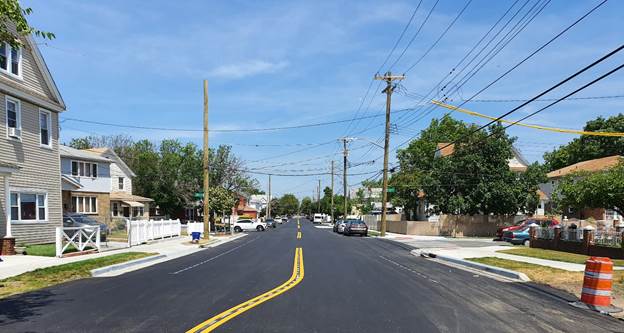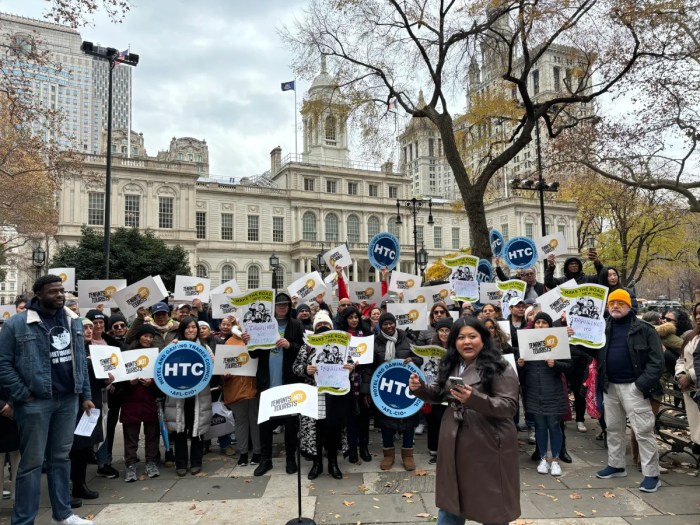A $17.3 million project to improve street conditions, alleviate flooding and upgrade infrastructure in Rosedale has been completed two months ahead of schedule, city officials announced on Friday, Sept. 24.
Mayor Bill de Blasio and the NYC Department of Environmental Protection (DEP), NYC Department of Transportation (DOT) and the NYC Department of Design and Construction (DDC) announced the installation of 5,000 feet of new water mains, 2,800 feet of new storm sewers, and 44,000 feet of new or rebuilt sidewalks to make the neighborhood more resilient than ever.
The project is part of a $2.2 billion investment by the de Blasio administration to build a comprehensive drainage system, improve street conditions and alleviate flooding in southeast Queens.
The program, the largest of its kind, consists of 43 projects overall, including 16 that are substantially completed, five that are in active construction and 11 that are in design.
“As extreme climate events become more frequent, infrastructure investments in our roads and sewers only become more critical,” de Blasio said. “The completion of this project will not only improve Rosedale’s street conditions and alleviate flooding, it will also ensure safer and more resilient streets for years to come.”
DEP Commissioner Vincent Sapienza said the $17.3 million investment to install new storm sewers and catch basins in Rosedale delivers on the de Blasio administration’s commitment to upgrading and improving the drainage infrastructure in southeast Queens.
“I want to thank our partners at DDC and DOT for their impressive work on this project, completing it about two months ahead of schedule and just in time for hurricane season,” Sapienza said.
Work in Rosedale occurred on 10 individual blocks. More than one mile (5,500 feet) of water mains — some of which were installed before World War II — were replaced with new pipes ranging from eight to 12 inches in diameter. Fire protection was enhanced with the replacement of 15 fire hydrants and installation of four new fire hydrants. Two bollards were placed in front of each fire hydrant to protect them from potential vehicle damage.
A total of 2,780 feet of new storm sewers were added to the neighborhoods, ranging in size from 15 inches in diameter up to 3 feet by 5 feet. To better capture stormwater and direct it to the new storm sewers, 35 new catch basins were installed and nine existing ones were replaced.
Nearly 300 feet of new 10-inch sanitary sewers was installed and 400 feet of sanitary sewers were replaced with pipes ranging from 10 to 12 inches. Two new underground sewer chambers help the new infrastructure in the neighborhood operate at peak efficiency.
As part of the final street restoration, 17,570 square yards of new asphalt was laid down over a new concrete base and 43,775 square feet of sidewalk and 8,775 feet of curbs were added or rebuilt.
Throughout the project area, 27 old trees were removed, but 57 new trees were planted, resulting in a net gain of 30 trees overall.
Compliance with the American with Disabilities Act (ADA) was improved with the replacement of 39 old pedestrian ramps and the addition of 10 new ADA-compliant ones.
DOT Commissioner Hank Gutman said they’re committed to continuing to work with fellow agencies to keep the city’s roads in a state of good repair and protected from flooding.
“Extreme climate change events underscore the importance of infrastructure projects like this one, and these infrastructure upgrades represent a significant investment in southeast Queens,” Gutman said.
Meanwhile, DDC Commissioner Jamie Torres-Springer said they will continue to implement major infrastructure investments throughout southeast Queens with the DEP and DOT.
Lawmakers representing southeast Queens commended the three city agencies for completing the project on time. However, they also say there’s still more work to be done to help all neighborhoods affected by flooding.
Queens Borough President Donovan Richards thanked DEP, DOT and the DDC for working effectively to improve the quality-of-life of Rosedale’s residents.
“The completed work in Rosedale is an important investment in our borough’s future that will do a great deal to enhance street conditions, alleviate flooding, increase storm resiliency, and improve accessibility,” Richards said. “This work underscores the city’s strong commitment to alleviating chronic flooding and addressing our borough’s significant infrastructure needs.”
State Senator James Sanders Jr. said flooding is a persistent problem in Rosedale and other parts of southeast Queens and the Rockaways.
“I am glad the city is taking this seriously and making strides to help homeowners and businesses who suffer constant damage as a result of rising water,” Sanders Jr. said. “However, more needs to be done and I would like to see continued efforts by this administration to help all neighborhoods that are experiencing this issue.”
For as long as Assemblywoman Alicia Hyndman can remember, southeast Queens has had issues with flooding and rising groundwater, she said.
According to Hyndman, it’s important that the city’s agencies such as the DEP and DDC undertake projects such as this which would help address the issue in their neighborhoods.
“Although this is a great step in the right direction, a lot more needs to be done to ensure our neighborhoods, including homeowners and businesses who constantly have to deal with damages as a result of flooding are well taken care of,” Hyndman said. “I am grateful for the continuous work and dedication of DEP and DDC staff committed to upgrading and improving the drainage infrastructure in southeast Queens.”
As recent record-breaking storms as a result of climate change occur more frequently, Councilwoman Selvena Brooks-Powers said “the time to prepare is now.”
“This critical project is exactly what Rosedale needs to prevent the chronic flooding that routinely impacts our community,” Brooks-Powers said. “By investing in resilient infrastructure, expanding the capacity of our catch basins and storm drains, we can ensure safer streets across southeast Queens.”




































